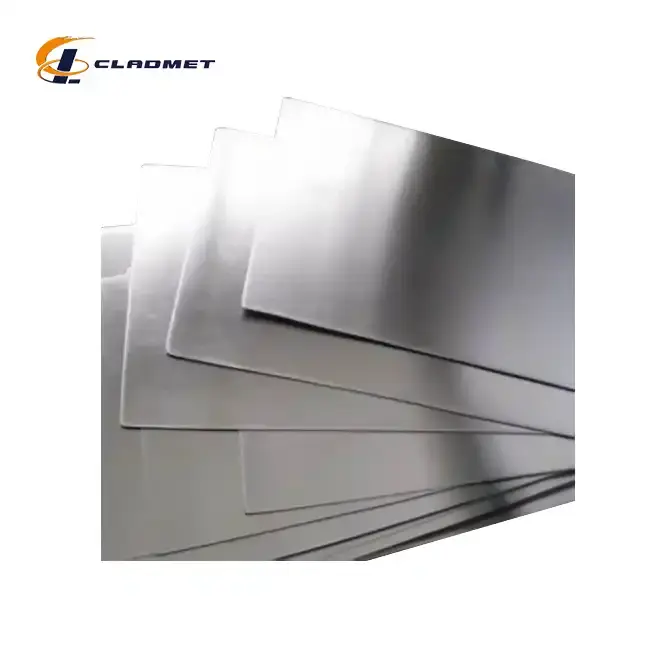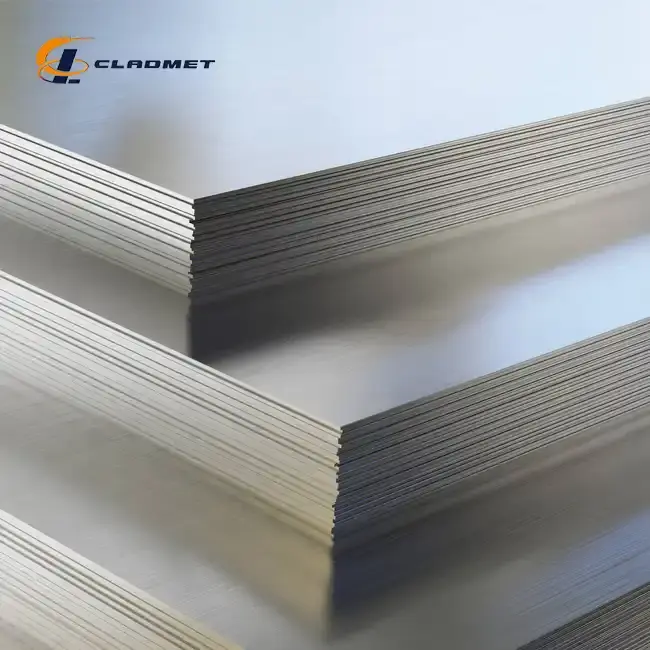Titanium Sheet Metal in Aerospace Applications
 2025-06-11 18:32:50
View:389
2025-06-11 18:32:50
View:389The aerospace industry stands as one of the most demanding sectors in modern engineering, requiring materials that can withstand extreme conditions while maintaining structural integrity and optimal performance. Among the various advanced materials utilized in aerospace manufacturing, titanium sheet metal has emerged as a cornerstone material that revolutionizes aircraft design and functionality. This exceptional metal combines remarkable strength-to-weight ratios, superior corrosion resistance, and outstanding durability, making it indispensable for critical aerospace components. From commercial aircraft fuselages to spacecraft heat shields, titanium sheet metal continues to push the boundaries of what's possible in aerospace engineering, enabling manufacturers to create lighter, stronger, and more efficient aircraft that meet the stringent safety and performance standards of the aviation industry.

Critical Properties and Performance Characteristics of Titanium Sheet Metal
Superior Strength-to-Weight Ratio in Aerospace Design
The fundamental advantage that makes titanium sheet metal irreplaceable in aerospace applications lies in its exceptional strength-to-weight ratio, which surpasses most conventional aerospace materials. This remarkable property allows engineers to design aircraft components that maintain structural integrity while significantly reducing overall weight, directly impacting fuel efficiency and payload capacity. Titanium sheet metal exhibits tensile strength comparable to steel while weighing approximately 45% less, making it particularly valuable for primary structural components such as wing spars, landing gear assemblies, and engine mounts. The material's high specific strength enables aerospace manufacturers to optimize design parameters, creating components that can handle tremendous stress loads without compromising the aircraft's weight budget. Modern commercial aircraft utilize titanium sheet metal extensively in critical load-bearing structures, where the material's ability to maintain its mechanical properties under varying temperature conditions ensures consistent performance throughout the flight envelope. Advanced titanium alloys, including Grade 5 titanium sheet metal, demonstrate yield strengths exceeding 880 MPa while maintaining excellent ductility, allowing for complex forming operations required in aerospace manufacturing.
Exceptional Temperature Resistance and Thermal Stability
Aerospace environments subject materials to extreme temperature variations, from sub-zero conditions at high altitudes to intense heat generated by high-speed flight and engine operations. Titanium sheet metal excels in these challenging thermal environments, maintaining its mechanical properties across a wide temperature range that spans from -253°C to 600°C. This thermal stability makes titanium sheet metal particularly valuable for components exposed to engine exhaust, such as nacelles, exhaust ducts, and heat shields, where conventional materials would fail or require extensive cooling systems. The material's low thermal expansion coefficient helps prevent thermal stress accumulation during temperature cycling, reducing the risk of fatigue failure in critical components. Engine manufacturers extensively utilize titanium sheet metal for compressor blades, turbine casings, and combustion chamber components, where the material's ability to retain strength at elevated temperatures ensures reliable operation under demanding conditions. Additionally, the material's thermal conductivity properties allow for effective heat dissipation, contributing to overall engine efficiency and component longevity in aerospace applications.
Outstanding Corrosion Resistance in Harsh Environments
The aerospace operating environment presents numerous corrosion challenges, including exposure to moisture, salt spray, industrial pollutants, and various chemical substances used in aircraft maintenance and operation. Titanium sheet metal demonstrates exceptional corrosion resistance due to its natural oxide layer formation, which provides a protective barrier against environmental degradation. This inherent corrosion resistance eliminates the need for protective coatings in many applications, reducing maintenance requirements and extending component service life significantly. Marine aerospace applications, including carrier-based aircraft and seaplanes, particularly benefit from titanium sheet metal's resistance to saltwater corrosion, where conventional materials would require frequent replacement or extensive maintenance. The material's immunity to stress corrosion cracking, a common failure mode in high-stress aerospace components, ensures long-term structural integrity even under sustained loading conditions. Furthermore, titanium sheet metal maintains its corrosion resistance even when subjected to mechanical damage, as the oxide layer rapidly reforms when exposed to oxygen, providing self-healing properties that enhance component reliability in aerospace service environments.
Manufacturing Processes and Quality Standards for Aerospace Titanium Components
Advanced Rolling and Forming Techniques
The production of aerospace-grade titanium sheet metal requires sophisticated manufacturing processes that ensure consistent material properties and dimensional accuracy across large production runs. Hot and cold rolling techniques are employed to achieve the precise thickness tolerances demanded by aerospace specifications, with thickness capabilities ranging from 0.5mm to 100mm to accommodate various component requirements. The rolling process must be carefully controlled to maintain grain structure uniformity, as inconsistencies can lead to anisotropic properties that compromise component performance. Modern titanium sheet metal manufacturing facilities utilize precision rolling equipment capable of maintaining thickness tolerances within ±0.025mm, ensuring consistent material properties throughout the sheet. Vacuum annealing processes are employed during manufacturing to enhance the material's strength, ductility, and oxidation resistance, while eliminating impurities that could affect aerospace performance requirements. The controlled atmosphere processing prevents contamination that could compromise the material's integrity, particularly important for critical aerospace applications where material purity directly impacts safety and reliability.
Rigorous Quality Control and Testing Protocols
Aerospace applications demand the highest levels of quality assurance, requiring comprehensive testing protocols that verify material properties and detect potential defects before components enter service. Titanium sheet metal destined for aerospace use undergoes ultrasonic testing to identify internal flaws, surface inspection to detect surface irregularities, and hardness testing to verify mechanical properties meet specification requirements. Dimensional accuracy checks ensure that the material meets the tight tolerances required for aerospace manufacturing, while chemical analysis confirms alloy composition compliance with aerospace material standards. Each batch of aerospace-grade titanium sheet metal receives certification documenting compliance with ASTM B265, JIS H 4600, and other relevant international standards, providing traceable quality documentation required for aerospace supply chain management. Advanced testing techniques, including X-ray fluorescence spectroscopy and electron microscopy, are employed to verify microstructural characteristics and detect trace contaminants that could affect long-term performance in aerospace environments.
Compliance with International Aerospace Standards
The aerospace industry operates under stringent regulatory frameworks that mandate compliance with international standards ensuring material safety, reliability, and performance consistency. Titanium sheet metal manufacturers must achieve and maintain certifications including ISO 9001:2015 quality management systems, PED (Pressure Equipment Directive) compliance for pressure vessel applications, and ABS (American Bureau of Shipping) certification for marine aerospace applications. These certifications require continuous monitoring of manufacturing processes, regular audits of quality systems, and ongoing verification of material properties to ensure consistent compliance with aerospace requirements. ASME and ASTM standards provide detailed specifications for titanium sheet metal composition, mechanical properties, and testing procedures, ensuring that materials meet the demanding requirements of aerospace applications. The certification process includes extensive documentation of manufacturing procedures, quality control measures, and testing protocols, creating a comprehensive quality system that supports aerospace supply chain requirements and regulatory compliance mandates.

Specific Aerospace Applications and Performance Benefits
Primary Structural Components and Airframe Integration
Modern aircraft design increasingly relies on titanium sheet metal for primary structural components where weight reduction and strength optimization are critical for overall aircraft performance. Wing box structures, fuselage frames, and landing gear components utilize titanium sheet metal to achieve optimal strength-to-weight ratios while maintaining the structural integrity required for safe aircraft operation. The material's excellent fatigue resistance makes it particularly valuable for components subjected to cyclic loading, such as wing attachment points and control surface actuators, where repeated stress cycles could cause failure in conventional materials. Aerospace manufacturers leverage titanium sheet metal's formability to create complex geometries required for modern aircraft design, including compound curves and integrated stiffening features that optimize structural efficiency. The material's compatibility with advanced joining techniques, including friction stir welding and electron beam welding, enables the creation of large structural assemblies with consistent material properties throughout the joint area, essential for maintaining structural integrity in critical applications.
Engine Components and High-Temperature Applications
Gas turbine engines represent one of the most demanding applications for titanium sheet metal, where components must withstand extreme temperatures, high-frequency vibrations, and corrosive combustion products while maintaining precise dimensional stability. Compressor blades, fan cases, and exhaust components utilize titanium sheet metal's unique combination of high-temperature strength retention and corrosion resistance to ensure reliable operation throughout engine service life. The material's low density compared to superalloys allows for reduced centrifugal loading in rotating components, enabling higher rotational speeds and improved engine efficiency. Advanced titanium alloys, including Grade 5 titanium sheet metal, demonstrate excellent creep resistance at elevated temperatures, making them suitable for components operating in the hot sections of gas turbine engines. Engine manufacturers appreciate titanium sheet metal's machinability and formability, which enable the production of complex internal cooling passages and aerodynamic surfaces required for optimal engine performance and efficiency.
Specialized Applications in Space Systems
Space applications present unique challenges that highlight titanium sheet metal's exceptional properties, including operation in vacuum environments, extreme temperature cycling, and exposure to radiation and micrometeorite impacts. Spacecraft heat shields, pressure vessel components, and structural frameworks utilize titanium sheet metal's combination of low outgassing properties, thermal stability, and structural efficiency to ensure reliable operation in the harsh space environment. The material's compatibility with cryogenic fluids makes it valuable for rocket propellant tanks and transfer lines, where conventional materials might become brittle or lose structural integrity at extremely low temperatures. Satellite structures benefit from titanium sheet metal's dimensional stability and resistance to thermal cycling, ensuring that precision instruments and communication equipment remain properly aligned throughout mission duration. The material's electromagnetic transparency characteristics make it suitable for antenna applications and electronic equipment housings where signal transmission must not be compromised by structural materials.
Conclusion
Titanium sheet metal continues to revolutionize aerospace engineering through its unmatched combination of strength, durability, and lightweight properties. From enhancing fuel efficiency in commercial aviation to enabling breakthrough technologies in space exploration, this remarkable material drives innovation across the aerospace industry. The ongoing development of advanced manufacturing techniques and quality control processes ensures that titanium sheet metal will remain at the forefront of aerospace materials technology, supporting the industry's pursuit of safer, more efficient, and environmentally sustainable aircraft designs.
Ready to elevate your aerospace projects with premium titanium sheet metal? Baoji JL Clad Metals Materials Co., Ltd. brings nearly four decades of expertise in titanium manufacturing, backed by ISO 9001:2015, PED, and ABS certifications. Our advanced manufacturing capabilities, comprehensive R&D support, and commitment to quality make us your ideal partner for aerospace applications. Whether you need standard specifications or custom solutions, our OEM services ensure precise manufacturing to your exact requirements. Contact our expert team today at sales@cladmet.com to discuss your titanium sheet metal needs and discover how our innovative solutions can enhance your aerospace projects with competitive pricing and reliable delivery.
References
1. Boyer, R., Welsch, G., & Collings, E.W. (2007). Materials Properties Handbook: Titanium Alloys. ASM International Press, Materials Park, Ohio.
2. Lütjering, G., & Williams, J.C. (2018). Titanium: Engineering Materials and Processes for Aerospace Applications. Springer-Verlag, Berlin Heidelberg.
3. Donachie, M.J. (2000). Titanium: A Technical Guide for Engineers and Designers. ASM International Materials Engineering Series, Second Edition.
4. Peters, M., Kumpfert, J., Ward, C.H., & Leyens, C. (2003). Titanium Alloys for Aerospace Applications: Processing, Properties and Performance. Advanced Engineering Materials, Volume 5, Issue 6.
5. Banerjee, D., & Williams, J.C. (2013). Perspectives on Titanium Science and Technology for Aerospace Structures. Acta Materialia, Volume 61, Issue 3.
6. Froes, F.H., & Eylon, D. (1990). Powder Metallurgy of Titanium Alloys: Processing and Applications in Aerospace Industry. International Materials Reviews, Volume 35, Issue 1.

_1737007724117.webp)
_1736996330512.webp)









